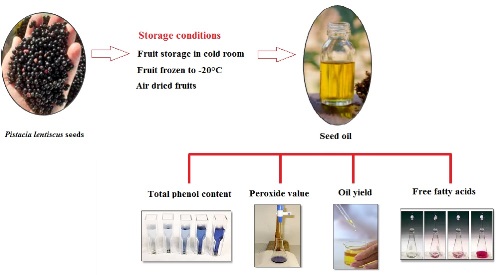
Effect of fruits storage conditions on the yield and the quality of Pistacia lentiscus oil
Abstract
This study aims to determine the effect of fruit storage conditions on the yield and quality of Pistacia lentiscus oil. Fruits were harvested in North Tunisia, and oil was extracted using the pressing method. Three storage conditions were tested; fruit is frozen at -20°C, fruit storage in a cold room at 4°C, and air-dried fruits at 25°C. Oil yield, free fatty acids, peroxide value, and total polyphenolic content were determined after 30, 60, and 90 days of storage. During the first 30 days, the highest yield was reached by fruits stored in a cold room (15%). Oil acidity from freshly harvested lentisk fruits was around 6% and then increased during storage. With increasing storage time, the oil peroxide value and the total polyphenolic content decreased in the fruits from all treatments. The peroxide value reached the respective values of 8, 5, and 23 meq O2/kg oil for Frozen, Cold Room, and Air Drying treatments. The total polyphenolic content varied from 0.5 EGA/g oil for air drying and frozen treatments to 0.8 EGA/g oil for the cold room. This study allowed the determination of the optimal conditions of storage of Pistacia lentiscus oil. These results are important to preserve the oil's quality and chemical and medicinal properties.
Full Text:
PDFReferences
F. Mezni, A. Maaroufi, M. Msallem, M. Boussaid, M.L. Khouja, A. Khaldi, Fatty acid composition, antioxidant and antibacterial activities of Pistacia lentiscus L. fruit oils, J Med Plants Res., 2012, 6, 5266–5271.
H. Trabelsi, J. Renaud, W. Herchi, M.L. Khouja, S. Boukhchina, P. Mayer, LC–ESI –QTOF–MS, MS/MS analysis of glycerophospholipid species in three Tunisian Pistacia lentiscus fruit populations, J Amer Oil Chem Soc., 2013, 90, 611–618.
Z. Maameri, K. Beroual, Z. Djerrou, S. Habibatni, B. Benlaksira, M. Serakta, H. Mansour-Djaalab, F. Kahlouche-Riachi, K. Bachtarzi, Y. Hamdi Pacha, Preliminary study to assess cicatrizing activity of honey and Pistacia lentiscus fatty oil mixture on experimental burns in rabbits, Inter J Med Arom Plants, 2012, 2, 476-480.
F. Mezni, C. Aouadhi, M.L. Khouja, A. Khaldi, A. Maaroufi, In vitro antimicrobial activity of Pistacia lentiscus L. edible oil and phenolic extract, Nat Prod Res, 2014. http://dx.doi.org/10.1080/14786419.2014.952232.
F. Mezni, S. Shili, N. Ben Ali, M.L. Khouja, A. Khaldi, A. Maaroufi, Evaluation of Pistacia lentiscus seed oil and phenolic compounds for in vitro antiproliferative effects against BHK21 cells, Pharmaceutical Biology, 2016, 1–5. http://dx.doi.org/10.3109/13880209.2015.1079222
P. Naibaho, Teknologi Pengolahan Kelapa Sawit (2nd edn), Medan, Indonesia: Pusat Penelitian Kelapa Sawit Medan, 1998, 306.
M.H. Noviar, S. Amzulrifin, Quality Control System of Crude Palm Oil on Palm Oil Processing Industry (Case Study Bah Jambi Palm Oil Mill, PTPN IV, Medan, North Sumatra), Intern J Scien Res Pub., 2016, 6, 101–106.
Z.A. Manaf, Assessment of the Oil Palm Seedlings Assistance Scheme on Fresh Fruit Bunch Yield and Income of Smallholders, Oil Palm Ind Econ J., 2013, 13 (1), 35–44.
M.E. Cuvelier, M.N. Maillard, Stabilité des huiles alimentaires au cours de leur stockage, 2012, 19, 125-132.
J. Velasco, C. Dobarganes, Oxidative Stability of Virgin Olive Oil, Eur J Lipid Scien Tech., 2002, 104, 661-676.
A. Riuz, M.J. Ayora-Canada, B. Lendl, A rapid method for peroxide value determination in edible oils based on flow analysis with Fourier transform infrared spectroscopic detection, The Analyst, 2001,126, 242-246.
M. Antolovich, P.D. Prenzler, E. Patsalides, S. Mcdonald, K. Robards, Methods for testing antioxidant activity, The Analyst, 2002,127, 183–198.
A. Judde, Prévention de l’oxydation des acides gras dans un produit cosmétique : mécanisme, conséquences, moyens de mesure, quels antioxydants pour quelle application ? Oil seeds Fats Crops Lip, 2004, 1, 414-418.
M. Pehluvan, T. Kaya, B. Dogru, I. Lara, The effect of frozen storage on the phenolic compounds of Morus nigra L. (black mulberry) and Morus alba L. (white mulberry) fruit, Fruits, 2015, 70, 117-122.
J.M. Camargo, A.T. Dunoyer, L.A. García-Zapateiro, The effect of storage temperature and time on total phenolics and enzymatic activity of sapodilla (Achras sapota L.), Rev Fac Nac Agro Med, 2016, 69. https://doi.org/10.15446/rfna.v69n2.59140.
G. Beltrán, M.T. Ruano, A. Jiménez, M. Uceda, M.P. Aguilera, Evaluation of virgin olive oil bitterness by total phenol content analysis, Eur J Lip Scien Tech., 2007, 109, 193–197.
T.H. Borges, A. Serna, L.C. López, L. Lara, R. Nieto, I. Seiquer, Composition and Antioxidant Properties of Spanish Extra Virgin Olive Oil Regarding Cultivar, Harvest Year and Crop Stage, Antioxidants, 2019, 8, 217-222.
A. Serrano, R. De la Rosa, A. Sánchez-Ortiz, J. Cano, A.G. Pérez, C. Sanz, R. Arias-Calderón, L. Velasco, L. León, Chemical components influencing oxidative stability and sensorial properties of extra virgin olive oil and effect of genotype and location on their expression, LWT., 2021, 136, 110257.
F. Ashine, S. Balakrishnan, Z. Kiflie, R. Kumar, B.Z. Tizazu, Parametric optimization of Argemone Mexicana Seed oil Extraction by Box-Behnken Experimental Design and the Oil Characteristics, Results in Chemistry, 2022, 4, 100570.
https://doi.org/10.1016/j.rechem.2022.100570.
Normes européennes NFEISO 660, septembre 2009, corps gras d’origine animale et végétale; détermination de l’indice d’acide et de l’acidité.
V.L.Singleton, J.A. Rossi., Colorimetry of total phenolics with phosphomolybdic phosphotungstic acid reagents, Am J Enol Viticult., 1965, 16, 144-158.
DOI: http://dx.doi.org/10.13171/mjc02301051658mezni
Refbacks
- There are currently no refbacks.
Copyright (c) 2023 Mediterranean Journal of Chemistry
